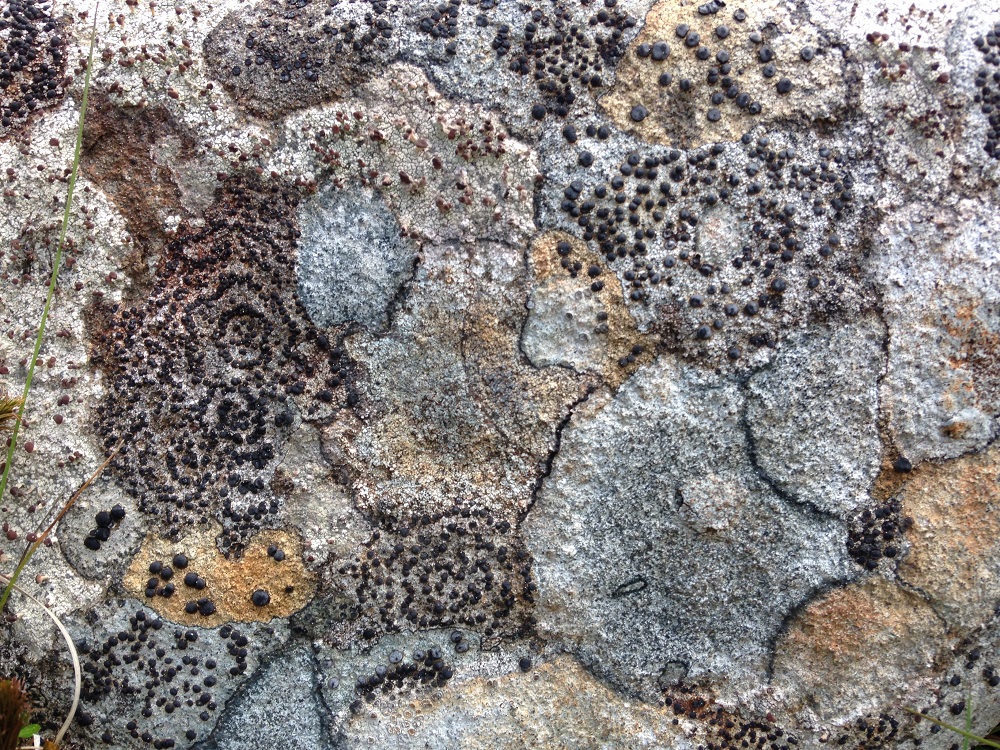
Lichenologists love long words. Not to be annoying or elitist, but as an aid to the precise description of complex structures. Most lichen identification books have a comprehensive glossary of terms but this shorter version may help to get you started. The terms for lichen growth forms and habits are shown separately below. (See also the comprehensive glossary edited by Mark Powell for the Revisions of British and Irish Lichens)
The lichen symbiosis
algae (sing. alga) – the photosynthetic partner of most lichens, most are microscopic unicellular or multicellular green algae
cyanobacteria – blue-green bacteria, the photosynthetic partner in some lichens.
mycobiont – the fungal partner
photobiont – the photosynthetic partner, an alga or cyanobacterium
Structure
apothecia (sing. apothecium) - round or elongate structures with a coloured surface that produces fungal spores, often with a surrounding margin of the same or a different colour
areolate - a crust divided into islands by cracks in the thallus
ascomata (sing. ascoma) – spore-producing bodies of ascomycete fungi
ascospores – the spores (usually 8) contained within an ascus
ascus (pl. asci) – sac-like cell(s) found within an ascoma and formed during the process of sexual reproduction, containing ascospores
asexual propagules – these contain both the fungal and photosynthetic partners needed for the lichen to disperse without the formation of sexual spores, e.g. soredia and isidia
conidia (sing. conidium) – fungal spores produced asexually
cortex – a structurally distinct outermost layer of a lichen thallus, usually with no algal cells, present in many but not all lichens
isidia (sing. isidium) – warty or coralloid outgrowths of the thallus, with a cortex and containing cells of the photosynthetic partner and the fungus; frequently these break off as asexual propagules
medulla – a generally loose layer of hyphae below the cortex and photosynthetic layer, often containing air spaces and crystals of lichen substances
podetia - the spikes or cups that make up the secondary thallus of a Cladonia or other complex lichen
propagule – a reproductive or dispersal body containing both the algal and fungal components, i.e. the photobiont and mycobiont
prothallus - a differently coloured border to a crustose lichen where the fungus is actively growing but there are no algal cells
pruina - a fine, white powder like the bloom on a plum
soralia (sing. soralium) - structures producing soredia
soredia (sing. soredium) – a flour-like or granular ball of cells of the photosynthetic partner surrounded by fungal hyphae; these are produced from cracks or pores in the thallus or on its surface and are asexual propagules.
thallus – the vegetative part of a lichen, containing fungal and algal cells
Growth forms
cladoniform - a primary thallus of granules or scales and a secondary thallus of spikes or cups
crustose - crust-forming with only the upper surface visible, growing on or in the substratum
foliose - leafy or flattened, with upper and lower cortical layers
fruticose - shrubby or pendant, radially symmetrical
leprose - a diffuse powdery mass with little or no structure
placodioid - crustose but with lobes round the edge
squamulose - small scales, attached at the base, often mat forming
Recording and identification
reference specimen – one that has been authoritatively named
substratum (pl. substrata) – the surface upon or within which a lichen grows
TLC – thin-layer chromatography: a method used to identity diagnostic chemical substances produced by lichens
vice-county – subdivisions of Great Britain & Ireland used for the purposes of biological recording. They provide a stable basis for recording using similarly-sized units, and although grid-based reporting has grown in popularity, they remain a standard in the vast majority of ecological surveys, allowing data collected over long periods of time to be compared easily. Their boundaries have remained unchanged by subsequent local government reorganisations, allowing historical and modern data to be more accurately compared. Vice-counties in Britain are numbered from 1–112; those in Ireland from H1–H40.
voucher specimen - one collected as evidence of the occurrence of a particular species in a place, or to support another type of data such as DNA or TLC or anatomical slides
Substrata and position
aquatic - submerged in water for all or some of the time
maritime - on or close to the shore, within the area affected by salt spray
littoral - on the shore, in the tidal zone that is covered by the sea for part of each day
bryophilous - on bryophytes (mosses or liverworts)
corticolous - on bark
foliicolous - on leaves
lichenicolous - on another lichen
lignicolous - on wood
saxicolous - on stone